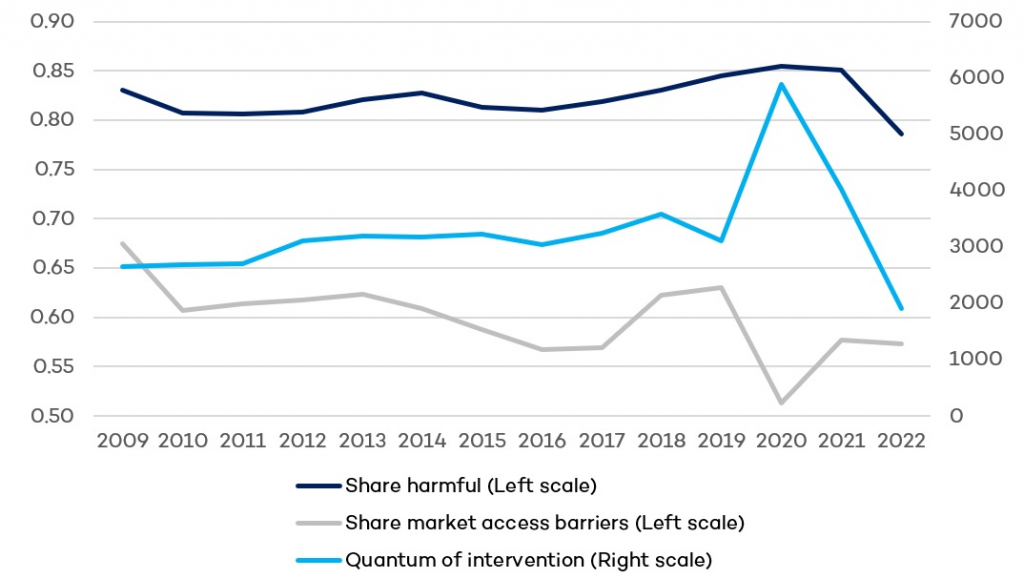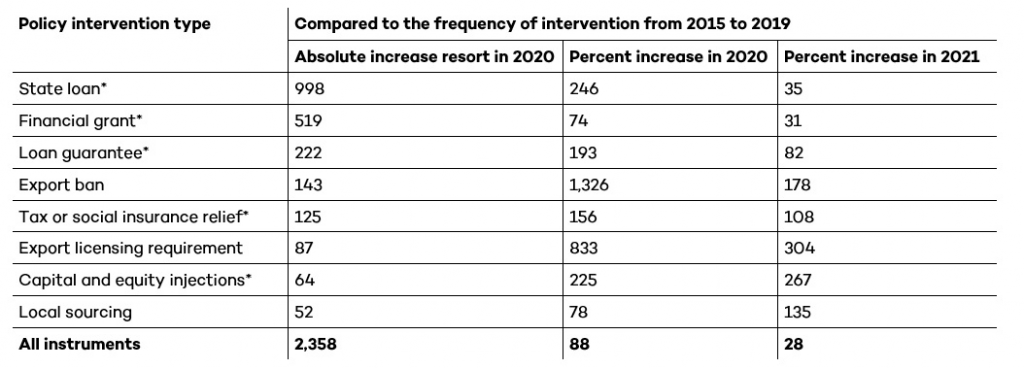Did COVID-19 Trigger a “New Normal” in Trade Policy?
Many shocks have occurred in the global trading system in the past two and a half years, but are these shocks different than the time before the pandemic? Simon Evenett, founder of the St. Gallen Endowment for Prosperity Through Trade, goes in depth on the different types of commercial policy intervention before and after the pandemic.
From time to time, it is useful to step back from the tumult of daily trade policy announcements to reflect on whether structural changes are afoot. Two-and-a-half years after COVID-19 was declared a global pandemic, what shifts have been witnessed in commercial policy decisions? Has there been anything more than a temporary change in the quantum of policy intervention? Has the propensity to liberalize or restrict trade changed? And what are the most common forms of commercial policy interventions?
Seasoned trade policy hands will recognize the importance of asking these questions after a profound global shock. Leading economic historians contend that “shocks” have little long-term impact on the extent of state discrimination against foreign-supplied goods and services. Those historians put more weight on “shifts” or longer-term, slowly evolving factors that prompt governments to resort to protectionism and affect the willingness of states to engage in trade and investment reforms. For what it is worth, until now I’ve leaned toward the view that both shocks and shifts matter. So what does the evidence say about commercial policy choices during the pandemic?
Reliably attributing policy changes in 2020 and 2021 to COVID-19 is easier said than done.
That is a harder question to answer than some might think. Reliably attributing policy changes in 2020 and 2021 to COVID-19 is easier said than done. Given the flexibilities in some World Trade Organization (WTO) accords for the protection of human life and for emergencies in general, there are concerns that some governments will relabel as pandemic-related the favouritism they intended anyway.
In their reports on developments in the world trading system, those brave souls in the WTO Secretariat distinguish between COVID-19-related measures and other policy interventions, now including government actions associated with the invasion of Ukraine. But the dependence of the Secretariat on WTO members to notify their policy intervention calls into question whether any findings are skewed toward liberalizing measures or removing trade restrictions.
As WTO Director-General Ngozi Okonjo-Iweala noted in her presentation of the latest Secretariat report, “Of the 436 trade and trade-related measures introduced on goods since the start of the pandemic, two-thirds were of a trade-facilitating nature, while one-third were trade-restrictive. Export restrictions accounted for 82% of all COVID-19 trade-restrictive measures, but nearly three-quarters of them have already been phased out.” While welcoming these developments, Okonjo-Iweala sensibly observed that “we are not in the clear yet.” Still, the overall thrust of the Secretariat report is that COVID-19 was a shock that, in trade policy terms if not in health terms, is now abating. Can this finding be confirmed with third-party evidence?
As international trade researchers well know, making assessments of aggregate trade policy stance is fraught. Still, needs must. At the start of the Global Financial Crisis, the WTO Secretariat bit the bullet and started reporting counts of policy intervention. The World Bank soon followed that approach, which has also been adopted by others. Everyone who has worked in this area knows how seriously to take such count statistics—yet they are still used widely in official circles to interpret trade policy dynamics.
Any Shifts in Commercial Policy Intervention?
In what follows, I will report the counts of different types of commercial policy intervention recorded in the independent Global Trade Alert (GTA) database. (Full disclosure: I created the GTA database in 2009 and have worked on it ever since.) Unlike the WTO Secretariat, I won’t take a stance on whether a government took a particular action because of the COVID-19 pandemic. Instead, I will check whether the overall commercial policy intervention witnessed since January 1, 2020, differed from the years before the pandemic.
The GTA database now contains information on more than 45,000 different state acts that can, in principle, affect cross-border commercial flows of goods, services, data, investment, and economic migrants. Information on government decisions relating to more than 60 different types of policy intervention has been collected, almost exclusively from official sources or from legally mandated declarations of firms. The database contains reports on policy interventions implemented since the beginning of November 2008, the month when G20 leaders first committed to eschew protectionism. As of this writing, the GTA has been mentioned in just under 3,000 studies in Google Scholar. It is widely regarded as one of the most comprehensive databases on commercial policy choices that is available to all.
One way the pandemic may have influenced trade policy dynamics is by increasing the quantum of observed intervention. Another is by altering the mix of policy intervention away from opening up to international trade, more often favouring domestic firms. The light blue line in Figure 1 plots the total number of commercial policy interventions recorded in the GTA database each year since 2009. Evidently, the quantum of intervention spiked in 2020, reaching a total of 5,885 state acts. So far, 4,016 policy interventions taken during 2021 have been recorded.
One way the pandemic may have influenced trade policy dynamics is by increasing the quantum of observed intervention.
Before concluding that the year 2020 was exceptional, please note two points. First, not all of the subsidies awarded in 2021 have been recorded yet, and this will go a long way to narrow the gap with the 2020 total, if it doesn’t eliminate the gap entirely. Secondly, even if no more policy interventions in 2021 were documented, the 4,016 total is still 25% larger than the mean number of commercial policy interventions recorded during the pre-pandemic years 2015 to 2019.
Figure 1. More policy intervention, yes; a turning point for policy mix, not clear

The blue line in Figure 1 reveals that the pandemic years 2020 and 2021 had little impact on the share of commercial policy interventions found to tilt the commercial playing field in favour of national firms and other local commercial interests. That share has been remarkably stable since 2009, hovering between 0.80 and 0.85. Pandemic or not, global financial crisis or not, austerity or not, year in and year out only one out of every five commercial policy interventions liberalizes cross-border commerce or otherwise improves conditions of competition for foreign firms. In this important respect, on the evidence available to date, the COVID-19 pandemic did not establish a “new normal” for trade policy.
However, a different conclusion emerges once attention is focused on higher profile import restrictions (tariffs, antidumping actions, anti-subsidy measures, tariffs on import surges, import quotas, government procurement measures, and local content requirements, etc.). This is shown by the grey line in Figure 1. The shares of salient measures affecting market access that harm foreign commercial interests have, with some ups and downs, declined on trend since the global financial crisis began. If anything, the large number of reforms of import policies affecting medical goods witnessed in 2020 accentuated that trend. A total of 771 import reforms were documented worldwide in 2020, up 61% from the mean number (of 480) during the pre-pandemic years, 2015 to 2019.
Greater Use of Corporate Subsidy Awards and Export Curbs
If the pandemic did not affect the share of harmful commercial policy interventions, while the share of salient policy changes affecting market access that are harmful fell, what accounts for the difference? The answer: growing use of corporate subsidy awards by governments and, during the pandemic, export curbs.
Table 1 shows that the number of export bans imposed in 2020 was at least 50 times higher than the average in the five previous pre-pandemic years (2015 through 2019). Of the eight policy interventions listed, five are forms of subsidy. Having written this, export bans and export licensing requirements saw the biggest percentage increases in harmful intervention. These measures were applied—often only for a short period of time—to trade in medical equipment (such as ventilators), medical consumables (such as personal protective equipment, of which masks are an example), and other COVID-19 medical materials and goods.
Table 1. Resort to harmful export bans and trade-distorting subsidies rose sharply

While many governments sought to blame international supply chains for shortages during the early phase of the pandemic, the record clearly shows that the public sector was an important source of disruption when firms were ordered not to ship to overseas customers. Once COVID-19 vaccines were developed, sadly the world witnessed in 2021 export curbs in various guises preventing the global distribution of vaccines. This counterproductive resort to export controls will have longer-term consequences as governments will be less willing to source medical items from abroad if there is a significant risk that orders won’t be fulfilled when foreign governments arbitrarily impose export limits. The willingness to liberalize trade is conditioned, quite reasonably, on trust in trading partners to supply—or, rather, not to frustrate supply during crises.
Three General Conclusions…for Now
What to make of this evidence? Inevitably, a caveat is in order: we are still collecting information on commercial policy intervention implemented in 2020 and 2021, so the following initial conclusions may need to be revised. First, the pandemic affected the quantum of commercially relevant policy intervention. To the extent that the effects of such policy intervention spill across borders, we should not be surprised that controversies arise. In times of crisis, aggressive monitoring of state action is need, not least to build and retain confidence and to discourage any temptation to move toward opportunistic favouritism.
The pandemic affected the quantum of commercially relevant policy intervention.
Second, the harm done to international supply chains by export curbs calls should presage tightening of the WTO rules on allowable exceptions (notably Article XX of the General Agreement on Tariffs and Trade). Studies showing the inefficient and counterproductive nature of export curbs should be prepared and shared widely now and whenever the temptation arises in future crises to block exports.
Third, the pandemic has not altered the trajectory toward an ever more distorted world trading system. That fewer salient import curbs were imposed is good news—but it implies that, even in our nominally open world trading system, competition between firms is less and less on the merits.
Simon J. Evenett is founder of the St. Gallen Endowment for Prosperity Through Trade, the institutional home of both the Global Trade Alert and Digital Policy Alert. He is also an economics professor at the University of St. Gallen, Switzerland.
You might also be interested in
Global Dialogue on Border Carbon Adjustments: The case of Brazil
This report consolidates, analyzes, and presents the views and perspectives of stakeholders from Brazil on border carbon adjustment (BCA) schemes to contribute to the global debate on BCA good practices.
Border Carbon Adjustments: Trinidad and Tobago country report
This report consolidates, analyzes, and presents views and perspectives of stakeholders from Trinidad and Tobago on border carbon adjustment (BCA) schemes to contribute to the global debate on BCA good practices.
Avoiding Trade Concerns in the Design of Plastic Pollution Measures
IISD provides insights on aspects of WTO members' plastics that have created friction with trading partners and suggests recommendations for the adoption of such policies in the future.
WTO Joint Initiative on E-Commerce State of Play
A finalized legal text of the e-commerce joint statement initiative agreement may be within reach: this report provides an overview of how close the participants are to the finish line and what remains to be agreed on.
